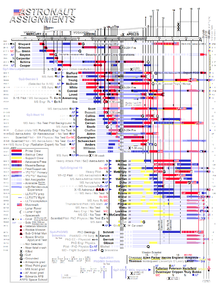- NASA Astronaut Group 7
-
Main article: List of astronauts by selection
Astronaut Group 7, referred to in some documents as the USAF MOL Transfer, was announced by NASA on August 14, 1969, and was the last group to be selected during the Apollo era. After the USAF Manned Orbiting Laboratory (MOL) project was cancelled, NASA hired seven of the astronauts selected for that program to form this "Group 7", roughly the younger half of the MOL astronauts. By the time they joined NASA, all Apollo flight assignments had been lined up, but four were given non-flying support assignments for Apollo. Group 7 went on to form the core of early Space Shuttle pilots, upgrading to commander after their first flight, flying 17 STS missions between them, plus the Approach and Landing Tests of Enterprise (OV-101).
A chart showing Group 7 assignments in relation to other astronaut groups up through the Apollo era. It clearly shows that by the time they were transferred from the military program to NASA, all flight assignments for Apollo had already been filled.
- Karol J. Bobko, USAF, (3 flights)[1]
- STS-6 Challenger — April 1983 — Pilot — TDRS A satellite deployment mission[1]
- STS-51-D Discovery — April 1985 — Commander — Anik C-1 and Syncom IV-3 satellite deployment mission[1]
- STS-51-J Atlantis — October 1985 — Commander — United States Department of Defense mission; DSCS-III satellite deployment[1]
- Robert L. Crippen, USN, (4 flights)[2]
- STS-1 Columbia — April 1981 — Pilot — Orbital test flight[2]
- STS-7 Challenger — June 1983 — Commander — Anik C-2 and Palapa B1 satellite deployment mission[2]
- STS-41-C Challenger — April 1984 — Commander — Long Duration Exposure Facility deployment and Solar Max repair mission[2]
- STS-41-G Challenger — October 1984 — Commander — Earth Radiation Budget Satellite deployment mission[2]
- Crippen would eventually serve as director of the John F. Kennedy Space Center.
- C. Gordon Fullerton, USAF, (2 flights + ALT)[3]
- ALT Enterprise — February through October 1977[3]
- STS-3 Columbia — March 1982 — Pilot — Research and development flight[3]
- STS-51-F Challenger — July 1985 — Commander — Spacelab mission[3]
- Henry W. Hartsfield, Jr, USAF, (3 flights)[4]
- STS-4 Columbia — June 1982 — Pilot — Research and development flight[4]
- STS-41-D Discovery — August 1984 — Commander — SBS-D, Telstar 3C, and Syncom IV-2 satellite deployment mission[4]
- STS-61-A Challenger — October 1985 — Commander — Spacelab mission[4]
- Robert F. Overmyer, USMC, (2 flights)[5]
- STS-5 Columbia — November 1982 — Pilot — SBS-C and Anik C-3 satellite deployment mission[5]
- STS-51-B Challenger — April 1985 — Commander — Spacelab mission[5]
- Donald H. Peterson, USAF, (1 flight)[6]
- STS-6 Challenger — April 1983 — Mission specialist — TDRS A satellite deployment mission[6]
- Richard H. Truly, USN, (2 flights + ALT)[7]
- ALT Enterprise — February through October 1977[7]
- STS-2 Columbia — November 1981 — Pilot — Remote Manipulator System testing[7]
- STS-8 Challenger — August 1983 — Commander — INSAT-1B satellite deployment mission[7]
- Truly would later serve as Administrator of NASA.
References
- ^ a b c d NASA (April 2006). "Astronaut Bio: Karol J. Bobko". http://www.jsc.nasa.gov/Bios/htmlbios/bobko-kj.html. Retrieved 2008-10-20.
- ^ a b c d e NASA (September 1997). "Astronaut Bio: Robert L. Crippen". http://www.jsc.nasa.gov/Bios/htmlbios/crippen-rl.html. Retrieved 2008-10-20.
- ^ a b c d NASA (January 2008). "Astronaut Bio: C. Gordon Fullerton". http://www.jsc.nasa.gov/Bios/htmlbios/fullerton-cg.html. Retrieved 2008-10-20.
- ^ a b c d NASA (August 1997). "Astronaut Bio: Henry W. Hartsfiled, Jr". http://www.jsc.nasa.gov/Bios/htmlbios/hartsfield-hw.html. Retrieved 2008-10-20.
- ^ a b c NASA (March 1996). "Astronaut Bio: Robert Overmyer". http://www.jsc.nasa.gov/Bios/htmlbios/overmyer.html. Retrieved 2008-10-20.
- ^ a b NASA (May 1994). "Astronaut Bio: Donald H. Peterson". http://www.jsc.nasa.gov/Bios/htmlbios/peterson-dh.html. Retrieved 2008-10-20.
- ^ a b c d NASA (March 1992). "Astronaut Bio: Richard H. Truly". http://www.jsc.nasa.gov/Bios/htmlbios/truly-rh.html. Retrieved 2008-10-20.
External links
NASA Astronaut Group 7, 1969 NASA Astronaut Groups · NASA Astronaut Corps Categories:- NASA astronauts
- Human spaceflight
- Lists of astronauts
Wikimedia Foundation. 2010.

